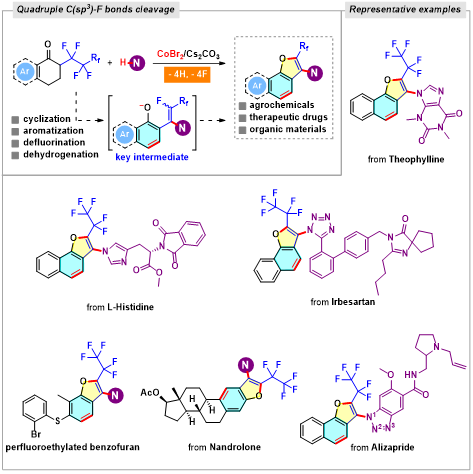Selective Quadruple C(sp3)-F Functionalization of Polyfluoroalkyl Ketones
Ting Xie,1#Guo-Qiang Wang,2#Ya-Wen Wang,1Weidong Rao,3Haiyan Xu,4Shuhua Li,2* Zhi-Liang Shen,1* and Xue-Qiang Chu1*
1Institute of Advanced Synthesis, School of Chemistry and Molecular Engineering, Nanjing Tech University, Nanjing 211816, China.
2Key Laboratory of Mesoscopic Chemistry of Ministry of Education, Institute of Theoretical and Computational Chemistry, School of Chemistry and Chemical Engineering, Nanjing University, Nanjing 210023, China.
3Jiangsu Provincial Key Lab for the Chemistry and Utilization of Agro-Forest Biomass, College of Chemical Engineering, Nanjing Forestry University, Nanjing 210037, China.
4School of Environmental and Chemical Engineering, Jiangsu University of Science and Technology, Zhenjiang, Jiangsu 212003, China.
#Contribute equally.
Summary:The significance of organofluorine compounds have inspired the establishment of numerous methods for the functionalization of rather inert C-F bonds. Despite advances achieved in the manipulation of C(sp2)-F bonds by employing transition-metal catalysts, such as Pd, Rh, Cu, Ni, Ru, and Ir, strategies that address the paucity of effectivepathways for selective activation of multiple C(sp3)-F bonds remained challenging.In this context, we present anunprecedented coupling-aromatization-cyclization reaction of polyfluorinated ketones with diverseN- andS-nucleophiles that forms regio-defined perfluoroalkylated naphtho[1,2-b]furan/benzofuran derivatives by harnessing Co-promoted distinctive quadruple C(sp3)-F bonds cleavage relay. This chemistry involving controlled and successive selective defluorination at heteronuclear centers would greatly contribute to the preparation of drug-like heterocycles as well as the late-stage elaboration of biorelevant compounds. Controlled experiments and DFT theoretical studies revealed that the combination of cheap cobalt salt with Cs2CO3enable expeditious C-Ffunctionalization.

iScience2020,23, 101259. (Impact factor: 4.447).
论文链接:https://www.cell.com/iscience/fulltext/S2589-0042(20)30445-4
